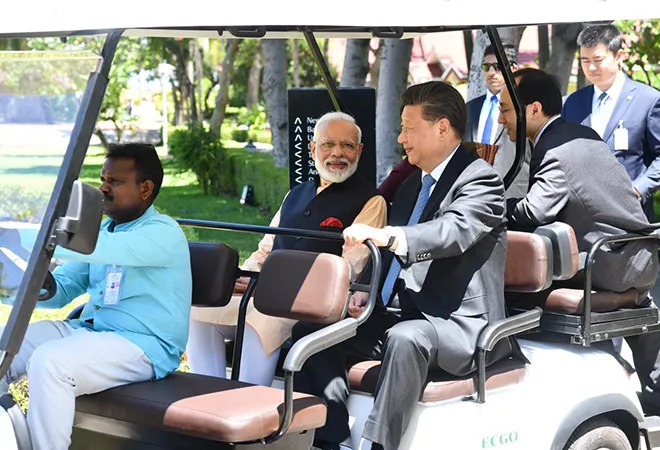-
CENTRES
Progammes & Centres
Location

If diplomacy was only about optics, then the ‘informal summit’ between Prime Minister Narendra Modi and Chinese President Xi Jingping in Mamallapuram was a resounding success. But beyond the optics, both sides have a somewhat blurred vision about where they see their relationship heading. Truth be told, there isn’t really any convergence in Chinese perception of India, and India’s perception of itself. Without this, there can be no clarity on where both sides want to take their relationship in the future. Clearly, China and India are not only not singing from the same song sheet, but also singing ever more discordant notes. Mamallapuram is unlikely to change this.
Engagement with the Chinese at every level – formal and informal, structured and unstructured, professional and business, academic and personal – is both desirable and necessary. But excited expectation attached to every high-level engagement between the top leaders of India and China is a bit over the top. Unstructured and informal summits have their uses, but they also have their limitations in terms of tangible takeaways. To be sure, just like after Wuhan, both sides will say all the right and positive things after Mamallapuram, even issue ‘strategic guidance’ to officials. But on ground very little is likely to change.
Here is the thing: all the historical symbolism attached to the location of the informal summit, and harping on ancient ties adds up to nothing in this day and age if the other side either doesn’t get the message or doesn’t value it. Let us face it. The past matters only if both sides want to use it to build something for the future. Otherwise, it is irrelevant, even meaningless. The future, of course, isn’t just about what sort of a relationship India wants. It is also about whether or not China wants a corresponding relationship. There is no sign of that.
The Wuhan summit might have reduced the Doklam-related tensions, and given a veneer of stability to the India-China relationship. No one expected Wuhan to resolve all problems between China and India. Even so, there was an expectation that it would give a positive direction to the bilateral relationship. Unfortunately, the hope that the Chinese leadership would have gained a better appreciation and understanding of India’s concerns and sensitivities about its core interests has since been belied. Forget about delivering something substantive on outstanding issues like trade or border demarcation, the Chinese have displayed undiluted hostility towards India, especially on a core interest like Jammu and Kashmir.
Regardless of the nonchalance of Indian officials over the Chinese attitude on J&K – it doubled down in favour of Pakistan by raising the issue in the UN Security Council, supporting Pakistan in UNHRC (the irony of China talking Human Rights was quite breath-taking), inviting Imran Khan on the eve of Mamallapuram and declaring that “Xi was watching Kashmir” – the fact remains that this issue cannot be brushed under the carpet.
There is no question of Sino-Indo ties improving and trust developing between the two countries if China questions and undermines India’s sovereignty and backs an enemy country like Pakistan over India. It is crazy for anyone in India to offer China an alibi on Pakistan. The bottom line is that China’s interests and stakes in the Islamic State of Pakistan are unacceptable if they come at the cost of India’s interests.
On virtually every other thing – border problems (the Chinese don’t want a solution unless it is on their terms), trade (both bilateral and multilateral where China’s sharp business practises are an obstacle to fair trade), security and strategic issues (Chinese expansionism, Freedom of Navigation, tolerance and support for Pakistani terrorists and terror groups, stabilising Afghanistan, India’s NSG membership), BRI related debt-trap diplomacy – there has been little to no give from the Chinese side.
All we have is the standard formulation that officials have been instructed to meet and thrash out these issues. Attaching hope to people-to-people relations and increased tourism as a way forward is self-delusional. The Chinese have weaponised tourism. And people-to-people ties won’t lead to a breakthrough given that China is not a country that runs on public opinion.
Although the visuals from Mamallapuram suggest that both Modi and Xi are quite relaxed around each other, the personal chemistry between the two leaders hasn’t really translated into any major breakthrough in the bilateral relationship. Given the growing power imbalance with China and given that China isn’t exactly been friendly, India will need to balance the growing asymmetry.
But the balancing game is easier said than done. For one, the partners we need to balance China aren’t exactly proving to be very reliable. Russia is now firmly in the Chinese camp. The US under Trump has proven to be notoriously capricious. For another, it isn’t clear if India is ready to enter into formal alliance arrangements – in part because India wishes to remain wedded to the fiction of ‘strategic autonomy’ – without which the balancing game is a bit of a pie in the sky. In the end, India will have to build and rely on its own economic and military sinews to manage the rise of China. Wuhan, Mamallapuram and other such events aren’t going to change this reality.
This commentary originally appeared in Mail Today.
The views expressed above belong to the author(s). ORF research and analyses now available on Telegram! Click here to access our curated content — blogs, longforms and interviews.

Sushant Sareen is Senior Fellow at Observer Research Foundation. His published works include: Balochistan: Forgotten War, Forsaken People (Monograph, 2017) Corridor Calculus: China-Pakistan Economic Corridor & China’s comprador ...
Read More +